Examples of writing
Graffito on a potsherd from Grotta Vanella (Segesta)

Source:
IAS I n. 321
Fragment of surface of a black painted vase, 5th century B.C., from Grotta Vanella (Segesta), IAS I n. 321, p. 87.
The letters have been scratched on after firing from left to right in two lines along the outer surface of the vase:
1. ]σαρι?[
2. ]ιχϝουγοτι[
Graffito on a potsherd from Grotta Vanella (Segesta)

Source:
IAS I n. 313
Fragment of surface of a vase, 5th century B.C., from Grotta Vanella (Segesta), IAS I n. 313, p. 84.
The inscription runs from left to right and it has been written in scriptio continua on the outer surface of the vase on a single line:
]δουhεναεμι[
The text shows the verb εμι “I am” preceded by the word δουhενα, marked by the indigenous ending -α. The word, that probably recurs also in IAS I nr. 320 in the formal variant δ̣οϝ̣ενα (and that could to be completed in IAS I nr. 193 and IAS nr. 255), is not a proper noun, but a possible name for the object, and in this case the word probably is related to the same root known in Lat. dōnum (see IAS I , pp. 156-158 with related bibliography).
Graffito on a potsherd from Grotta Vanella (Segesta)

Source:
IAS I n. 323.a e 323.b
Fragment of a low-footed cup, 5th century B.C., from Grotta Vanella (Segesta), IAS I n. 323.a and 323.b, p. 88.
The fragment attests two inscriptions, written from left to right and in scriptio continua in two different parts of its surface, respectively (a) written in the interior surface of the foot, and in the internal bottom of the cup:
323.a
1. ]φιβνυνν[
2. ]ν̣υhανε̣[
323.b
1. ]σαριχυ̣[
2. ]πειhιει[
3. ]κιμυτ[
4. σαρι[
Graffito on a potsherd from Montelepre, Monte d’Oro necropolis (Palermo)
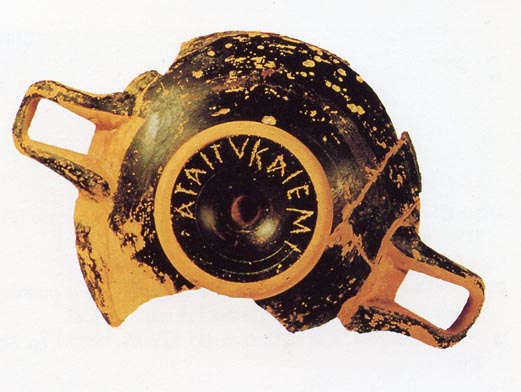
Source: C. Greco, "Monte d'Oro e la necropoli in località 'Manico di Quarara'", in AA.VV., "Di terra in terra. Nuove scoperte archeologiche nella provincia di Palermo", Palermo 1991, fig. 6 p. 201.
The inscription runs from left to right in scriptio continua; it appears complete and it has been written after firing on a single line and on the interior surface of the foot of an Attic black painted kylix, 5th century B.C.
The inscription comes from the necropolis founded at Manico di Quarara, on the slopes of Monte d'Oro of Montelepre (see IAS n. 319, p. 86, and Greco 1991, p. 201 fig. 6):
αταιτυκαιεμι
It seems correct to divide the text in αταιτυκαι εμι, and to recognize in it the verb εμι “I am” and an onomastic sequence αταιτυκαι showing the indigenous ending -αι, the most common marks in the corpus of non-Hellenic inscriptions. It remains sub iudice whether the ending -αι is an onomastic formula with a single name (αταιτυκα) or with two nouns (ατα τυκα) to be referred to a single offer, or even if this ending marks two single formulae, consisting both in a single personal name related to two distinct offers, respectively named ατα and τυκα). In any case, the relationship between ατα and the personal name Ατος occurring at Selinous is not insignificant (see IAS, pp. 161, 169).
Graffito on a potsherd from Monte Castellazzo di Poggioreale (Trapani)

Source: A.M.G. Calascibetta, "Un graffito elimo da Monte Castellazzo di Poggioreale", "ASNSP" s. III, XX, 1990, pp. 19-22.
Fragment of a lip of a Greek commercial amphora, early middle 5th century B.C., from Monte Castellazzo di Poggioreale, see Falsone 1988-1989, in particular p. 311; Calascibetta 1990; now Appendice, pp. 29-30 n. *435.
The alphabetic signs have been written from left to right on the upper part of the lip; the inscription seems incomplete (almost) on its right part:
]τιαιεμ[
Even if the inscription is not complete, the readable letters relate this text from Monte Castellazzo di Poggioreale as one of the recurring morphosyntactic schemes known in the Elymian vase corpus. It is possible to recognize in the sequence ]τιαι the indigenous ending -αι, that probably marks an onomastic root written before the verb “I am”, to identify and to complete in the sequence εμ[ι].
Graffito on a potsherd from Grotta Vanella (Segesta)
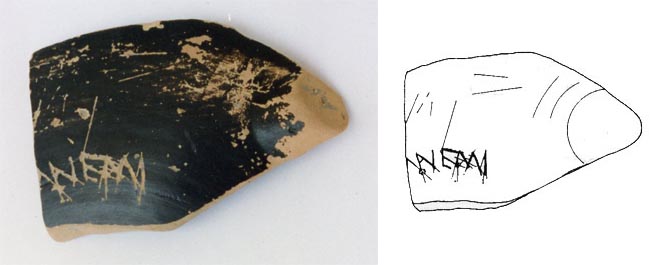
Source: L. Biondi, "Nuovi frammenti ceramici graffiti da Segesta", in AA.VV., "Atti delle Seconde Giornate Internazionali di Studi sull'Area elima (Gibellina, 22-26 ottobre 1994)", Pisa 1997, pp. 141-142, tav. XVII, 1.
Fragment of the side of a black-painted kylix, end 6th c. - mid 5th century B.C., from Grotta Vanella, see Biondi 1997, pp. 141-142 n. 1, table XVII, 1; 1998, pp. 366-367 n. 1, table LIVa, now Appendice, p. 26 n. *431. The inscription has been written on the outer surface of the kylix, with scriptio continua and from left to right. The text lacks its beginning, but it is complete in its final part:
]α̣αιεμι
The text can be divided as ]α̣αι εμι and exhibits the formulaic scheme -αι, that here probably is found in its variant -α̣αι, if the first of the letters preceding the verb εμι “I am” can be interpreted as <α>. The sequence probably belongs to a personal name.
Graffito on a potsherd from Grotta Vanella (Segesta)
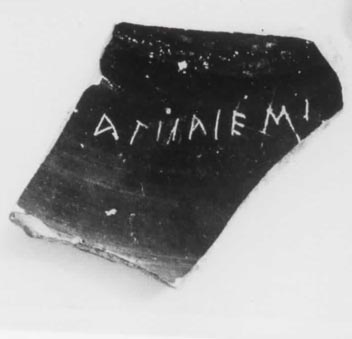
Source: L. Biondi, "Riflessioni sull'onomastica segestana", in AA.VV., "Terze Giornate Internazionali di Studi sull'Area elima (Gibellina - Erice - Contessa Entellina, 23-26 ottobre 1997)", I, Pisa - Gibellina 2000, pp. 136-141 n. 2, tav. XXVII, 2.
Fragment of a basin of a black-painted kylix, 5th century B.C., from Grotta Vanella, see Biondi 2000, pp. 136-141 n. 2, table XXVII, 2.The inscription is complete and it has been written on the interior surface of the basin, with scriptio continua from left to right:
ατιιαιεμι
The text can easily divided into ατιιαι and εμι, respectively the personal name of the person offering, ending with the indigenous morpheme -αι and the verb εμι “I am", according to the most common formulaic scheme in the Elymian graffiti corpus.
Graffito on a potsherd from Contrada Mango

Source: V. Tusa 1980-1981, p. 851 n. 2, tav. CCXV fig. 2;
Appendice, pp. 8-9 n. *372
Inscription incised under the foot of a black glazed Attic bowl from area of the sanctuary of Contrada Mango at Segesta:
[-(-)]ιρεναπεαι
Graffito on a potsherd from Entella
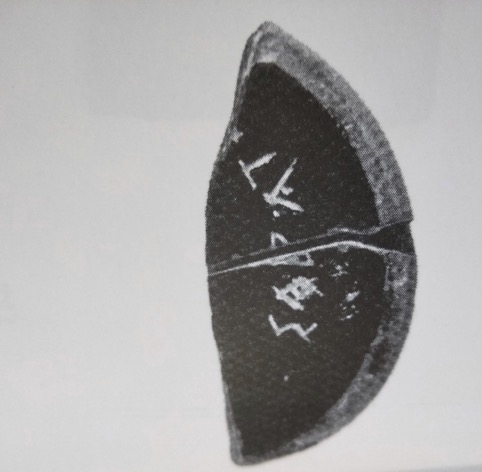
Source: L. Biondi 1992;
Appendice, p. 30 n. *436
Inscription incised after firing onto the foot of a black glazed Attic bowl from Entella:
σαβατ?[
Inscription on a small clay pyramid from Entella

Source: L. Agostiniani - M. De Cesare - L. Energren 2014;
Appendice, pp. 35-36 n. *444
Inscription incised - at that stage of the drying process which, for vases, is called “leather texture” - on a loom weight from Segesta, probably from an early 1980s excavation:
σαριτυυ[-]αιαισ[-]τινα
Coin legend (Segesta)
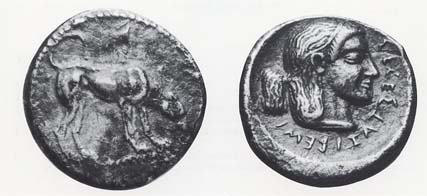
Source: Hurter 2008, n. 23b p. 62 (Periode I Reihe 2), p. 173 fig. 18, tav 2 n. 23 p. 181.
Segestan Didracmon, datable to 475/70-455/50 ca. B.C., with on the verso the Elymian legend: σεγεσταζιβεμι.
Coin legend (Segesta)
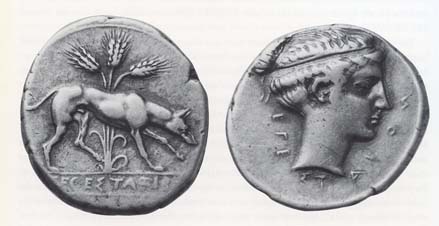
Source: Hurter 2008, n. 193f pp. 104-105 (Periode IV Reihe 12), p. 52 fig. 8, tav. 17 n. 193 p. 211.
Segestan didracmon, datable to 412/10-400 (and further on) ca. B.C., with a bilingual Greek-Elymian legend: on the recto the Elymian ethnic σεγεσταζιβ (written with a moon-shaped gamma ), on the verso the Greek ethnic εγεσταιον.
Coin legend (Segesta)
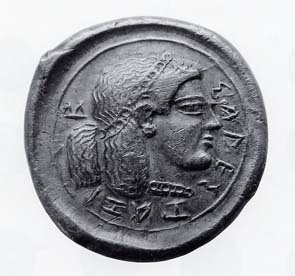
Source: Hurter 2008, n. 36a p. 65 (Periode I Reihe 3), p. 177 fig. 20, tav. 3 p. 183 n. 36.
Segestan didracmon, datable to 475/70-455/50 ca. B.C., with on the verso the Elymian legend: σεγεσταζιβ (Boston, Museum of Fine Arts).